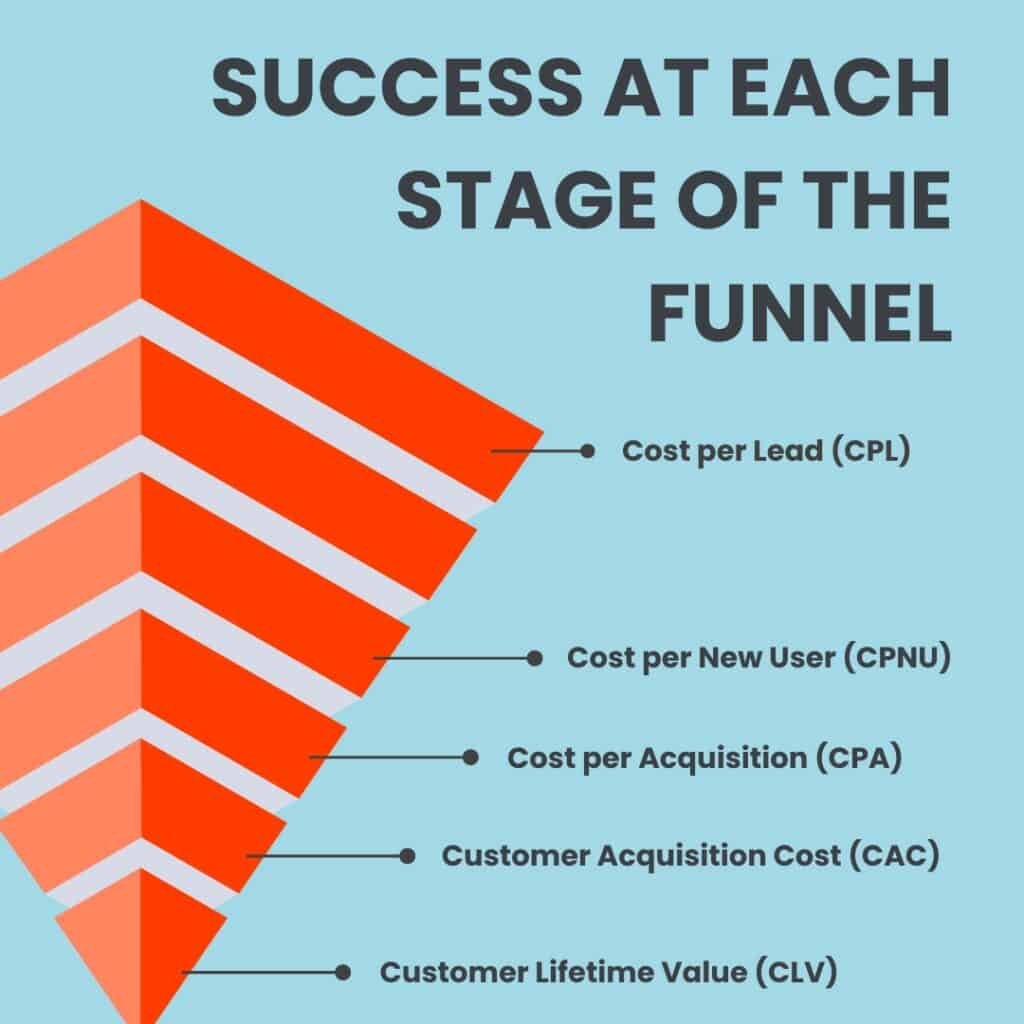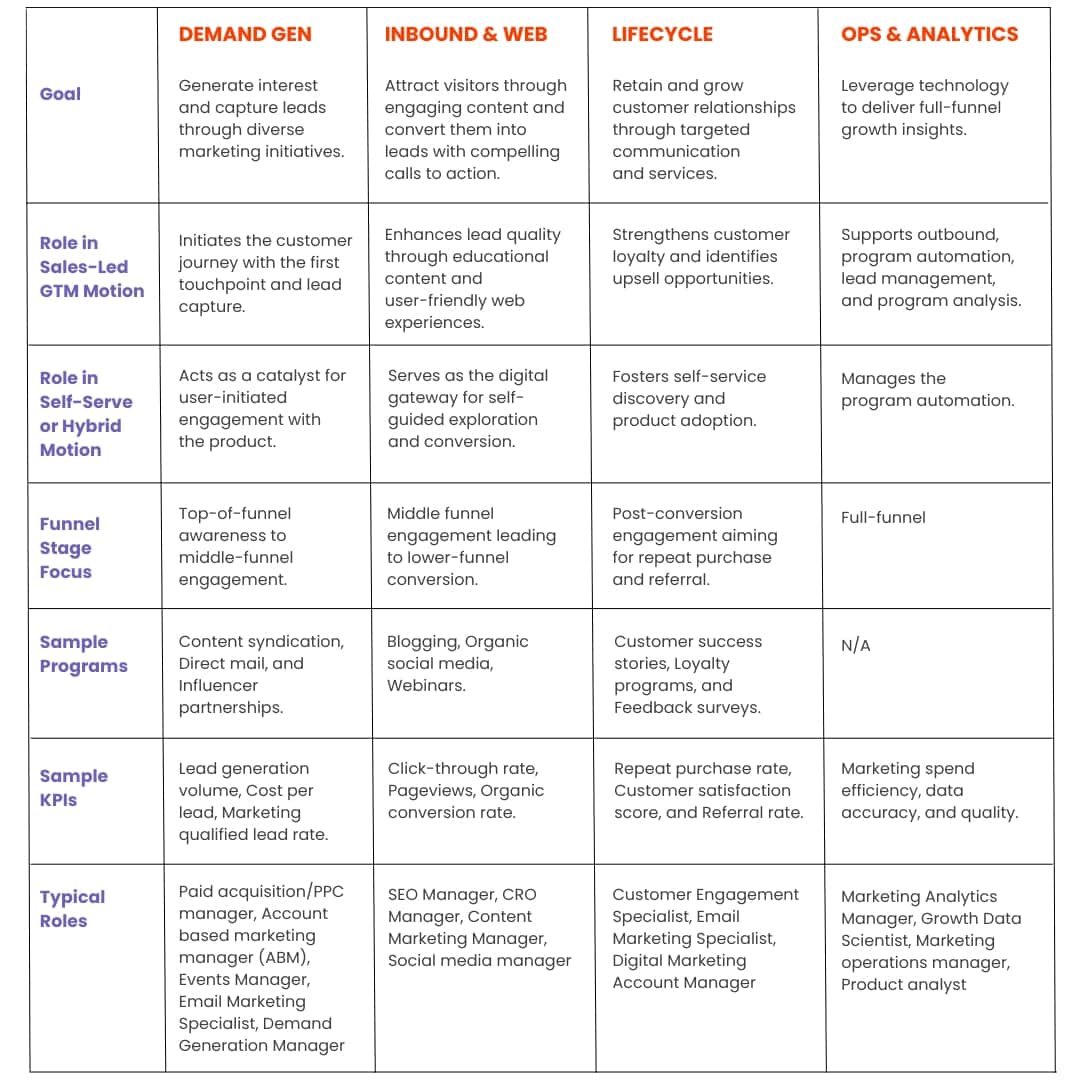How do you build and hire a marketing demand generation and growth team in 2025? Here’s our advice…
As businesses navigate through a clouded economic climate, making connections, building relationships, and creating loyal customers at scale become vital parts of any company’s survival, let alone its success.
For marketing teams, this has accelerated the need to be a foundational revenue source – one that consistently delivers pipeline, improves pipeline velocity, and increases return-on-investment. It also means a radical transformation in their mandate, strategies, and more specifically, their organizational structure. To achieve this mandate requires businesses and their marketing leaders to harness the power of growth marketing, and by extension, demand generation.
Business leaders who embrace this shift and invest in building growth marketing and demand generation teams find themselves at an advantage. They are able to leverage marketing-sourced revenue as a resilient and reliable stream of growth. Marketing leaders, meanwhile, become viewed as credible business partners who have “a seat at the table” – influencing corporate-wide strategy, budget allocation, and human capital decisions.
So how do businesses capitalize on the competitive advantage brought about by growth marketing? And what does a high-performance growth marketing team look like?
In this article, we will dive in and define what growth marketing and demand generation is, discuss why the time to start building a growth marketing and demand generation team is now, explore the impact this team will have on your business, and show you how to build a modern growth marketing and demand generation team.
Table of contents:
What is growth marketing and demand generation?
Growth marketing defined
Growth marketing encompasses demand generation, inbound and web strategies, lifecycle marketing, and operational analytics. It’s a structural framework aimed at enhancing growth across the entire buyer journey, not just the outset. It relies on various sub-functions to support comprehensive, full-funnel marketing while strategically using data and analytics tools to drive spend efficiency and improve return-on-investment.
Growth marketing’s objective is to acquire users and thus drive revenue by deploying, tracking, and enhancing a suite of programs and campaigns across a range of channels. This multifaceted approach includes the management of proprietary distribution networks, paid promotional channels, events, inbound marketing, and account based marketing (ABM) techniques that complement and amplify the efforts of a sales team’s outbound engagements.
Growth marketing teams are typically responsible for the oversight of the corporate website and the integrated marketing technology infrastructure. They employ A/B testing and leverage marketing analytics to inform decisions and optimize advertising spend. A key component of their role also involves fostering deep relationships with Sales Development Representatives to fortify account-based marketing tactics, ensuring a cohesive and targeted approach to business growth. Growth marketing teams are most commonly found in product-led growth businesses and are more likely with B2C products, where the core focus is bringing more users into the product to experience its value.
“Growth marketing’s objective is to drive revenue by strategically deploying, tracking, and enhancing a suite of programs and campaigns across a range of channels, effectively navigating potential and current clients through the purchasing and repurchasing journey.”
Demand generation defined
Demand generation is a subset of growth marketing and is focused on both generating and capturing demand for a product or service. Demand generation goes beyond traditional marketing tactics that focus solely on immediate sales.
It aims to build long-term relationships with ideal customers by providing valuable information, addressing their pain points, and positioning the company as a trusted authority in its industry. Effective demand generation teams do more than just create leads, they educate the market and enable independent buying processes at scale so that ideal buyers come to them and engage when they’re ready to buy. Ultimately, demand generation helps to create a pipeline of engaged prospects who are more likely to convert into loyal customers.
Why invest in Growth Marketing and Demand Generation teams now?
Today’s business environment demands that revenue be treated as a “team sport” where achieving revenue goals is not the sole responsibility of the sales team, but rather a collective effort involving multiple departments within an organization, especially marketing. This underscores the critical need for skilled growth marketing and demand generation teams. But why now? The answer is rooted in three main factors.
Hedge against market uncertainty
First, in the face of an uncertain economic climate, businesses cannot afford to passively wait for customers to come to buy, even when they have a field sales force with in-person coverage. Growth marketing and demand generation teams enable businesses to drive awareness and engagement from prospects who are both “in” and “out” of market at scale, which delivers a significant competitive advantage. This is the essence of demand generation – creating demand for a product or service when buyers aren’t in a buying cycle (“out” of market), and capturing and converting them into customers when they are (“in” market).
→ Take growth through brand reputation as one example. Amidst economic turbulence, a Forrester survey discovered that 23% of high-growth B2B enterprises plan to enhance their reputation program budgets by at least 10%. This investment in brand reputation is not just about maintaining visibility but also about building trust with “out of market” buyers by cementing a company’s role as a positive force in society.
→ Historical data shows that businesses that increased their marketing spend during the early 1980s recession benefited from higher sales compared to those that didn’t. Moreover, downturns offer the chance to leverage a less crowded marketplace, increasing visibility and return on investment across marketing campaigns.
→ Smart Insights reports that SEO – a function owned by growth marketing teams – can yield over $22 for every $1 spent. By continuing SEO efforts during a recession, companies can take a larger share of search visibility and attract more traffic from motivated, “in-market” buyers.
Capitalize on changes to traditional buying processes
Second, the digital age has transformed purchasing processes. It has brought about a seismic shift in consumer behavior, with a marked transition from the tactile, in-person purchasing experiences of yesteryears to the convenience-driven, instant-access world led by eCommerce. This evolution has been rapid, with consumers now able to compare products and prices across a multitude of platforms, consult reviews and ratings, and make purchases from anywhere. The work done by growth marketing teams have been instrumental in enabling this transformation, which has also extended into the B2B sphere.
Influenced by the digital era’s evolution and the rise of e-commerce, B2B buying behavior has radically changed. Where once information was scarce and drawn from a few select sources like conferences, industry analysts, and early digital search engines, buyers now have a wealth of information at their fingertips. This shift from a “seller-controlled dialogue” to a “buyer-empowered research process” means that traditional go-to-market models, which lean heavily on solicited outbound sales outreach, are becoming more and more obsolete.
Instead, today’s B2B buyers are prioritizing peer recommendations, backed by self-serve, independent research via company websites, social platforms, digital and in-person communities, especially in early stages of the buying cycle. These are the channels that growth marketing and demand generation teams are responsible for influencing and owning.
Over 41 percent of businesses use review websites like G2 crowd, Upcity, and Clutch.co before purchasing software.
When traditional sales strategies fail to recognize this preference for autonomy and self-directed information gathering, the result is a misalignment that often leads to longer sales cycles, lower win rates, higher acquisition costs, and a less efficient go-to-market approach.
However, for companies willing to invest in these teams and change the way they connect with customers, the results are staggering. A McKinsey global survey of 2,500 B2B companies across industries found that those willing to shake up their sales models and embrace next-generation capabilities are growing revenue at twice the rate of GDP. These “outperformers”prioritize omnichannel capabilities, with an emphasis on digital. 32% more than half their customer interactions through digital channels, while 42% generate more than half their revenue through digital channels.
Future-proof your business with data
Third, growth marketing teams enable businesses to ingest and analyze information on the sources that are creating sustainable profitable revenue growth, thus future-proofing their business. These teams leverage customer relationship management (CRM) software and advanced analytic tools, enabling businesses to develop highly accurate ideal customer profiles, understand purchasing preferences, forecast future trends and customer behaviors, influence product development, improve customer experiences, and more.
What is a Growth Marketing Team’s Impact?
Growth marketing and demand generation are increasingly recognized not just as tools for expanding brand visibility or generating leads, but as vital cogs in the machine that drives the entire buying lifecycle. Their influence impacts key performance indicators that savvy executives pay close attention to: pipeline size and velocity, return on investment (ROI), and Net Promoter Score (NPS). These metrics are essential for businesses seeking not only to thrive in their markets but to shape them.
Improving top-of-funnel metrics through brand visibility through performance branding and thought leadership
Performance Branding
Growth marketing teams play a pivotal role in connecting and building brand affinity with the 95% of the market who are not ready to buy. They generally accomplish this in two distinct ways, first by leveraging performance branding, and second by leveraging thought leadership and establishing topical authority.
Performance branding represents a strategic blend of brand-building and performance marketing. As highlighted by McKinsey, the shift toward performance branding is changing how companies allocate their marketing budgets by applying targeted-performance marketing principles to branding activities like personalized email campaigns, targeted social media ads, and engaging web content. Marketing departments leveraging this achieving strategy are gaining clearer insights into consumer preferences early in the buying journey, translating to significant marketing efficiency gains and top-line growth.
But performance branding is only one part. Growth marketing teams play a critical role in enhancing brand visibility for B2B businesses by positioning their brands as category thought leaders.
Thought Leadership
By creating content that is high-quality, insightful, and focused on solving prospective customer’s pain points, growth marketing teams position their brands at the forefront of their industries. They create brand “thought leaders” who drive debates, shape perceptions, and influence decision-making at a macro level. They don’t just follow industry trends; they set them.
This level of influence substantially increases brand visibility and enables deeper customer engagement. In fact, a study by Edelman and LinkedIn found that B2B companies who effectively used thought leadership reported increased attraction of RFP invitations and a direct contribution to sales wins.
Indicators for measuring success generally include: Reach and impressions, brand recall, search engine visibility, organic and direct traffic, contact list growth, marketing qualified leads, and new monthly active users.
Driving pipeline and increasing pipeline velocity
Increasing Pipeline
With a focus on new user acquisition, lead generation, lead nurturing, and qualification, growth marketing plays an integral role in driving sales pipeline. Studies show that companies utilizing growth marketing strategies witness their sales pipelines grow up to 10-20% faster than their counterparts following the traditional methods.
Indicators for measuring success include: Sales Accepted Leads (SALs), Sales Qualified Leads (SQLs), and High Intent Revenue Opportunities (HIRO), all of which serve as crucial metrics for gauging sales pipeline health.
Accelerating Pipeline Velocity
One significant aspect where the impact of growth marketing can be seen is in pipeline velocity rates. Pipeline velocity is the speed at which leads move through the sales funnel. The calculation of pipeline velocity is based on a simple, yet powerful formula. It combines four distinct variables: the number of opportunities, the average deal size, the win rate, and the length of the sales cycle. Presented in a formulaic manner, it is:
Pipeline Velocity = Number of Opportunities x Average Deal Size x Win Rate / Sales Cycle Length.
Because growth marketing teams are focused on attracting and converting prospects who are best fit for the organization to service, they are able to generate more leads who convert into opportunities faster, at a larger deal size, with shorter sales cycle lengths. In fact, demand generation campaigns have been shown to increase pipeline velocity by 30%.
Improving marketing return on investment (MROI/ROI)
Growth marketing teams stand as a lynchpin for enhancing marketing ROI. Companies like Atlassian, Slack, and Shopify have demonstrated that centering product growth in their market strategies with the support of growth teams can unlock remarkable scaling potential.
These teams, by leveraging low customer acquisition costs and a product-driven distribution model, enable businesses to attract customers more cost-effectively than competitors. Their ROI is influenced by factors such as team alignment, skill sets, and the unique economics of a business.
But these teams don’t just improve ROI through product-centered growth programs. They leverage quick-start, test-and-learn programs to identify the channels, offers, and creatives that deliver the best “bang for your buck.” They also use data from net promoter scores (NPS) and establish customer feedback loops to not only increase customer/user retention but also drive new acquisition. They do this by leveraging repeat, referral, and customer advocacy programs to harness positive customer experiences and client networks to acquire new customers at lower cost-per-acquisition (CPA).
Indicators for measuring success include: Cost per lead (CPL), Cost per new user (CPNU), cost per acquisition (CPA), customer acquisition cost (CAC), and customer lifetime value (CLV).

How to build a growth marketing team?
Organizational Structure and Core Roles
In order to build a growth marketing team, it helps to have an understanding of how the team is divided and the core roles that support each.
Growth marketing can typically be divided into four key sub-functions, each with specialized roles and responsibilities. This depends on the size and stage of the organization, as well as the go-to-market motion.
For organizations that have not historically leveraged marketing as a revenue driver and are new to building a growth marketing team, priority should be given to filling the demand generation and inbound roles first. In many instances, these two functions can be combined since the two are focused on driving customer acquisition using complementary strategies and techniques.
Demand Generation:
This team works closely with product marketing and content marketing to fuel campaigns and events. Their primary role is to drive awareness and generate demand for the product or service.
• Sample KPIs: lead volume, lead quality (% ICP, SQLs), lead conversion (MQL to SQL, SQL to OPP, OPP to Closed Won), and program ROI (program CAC and CAC payback period, marketing dollar spend per $ revenue).
• Typical roles include: Paid acquisition / PPC manager, Account based marketing manager (ABM), Events Manager, Email Marketing Specialist, Demand Generation Manager.
Inbound & Web:
This function is responsible for attracting potential customers through content, search engine optimization (SEO), and optimizing the website’s conversion paths (CRO). They ensure the website is not only informative but also maximizes lead generation through effective conversion rate optimization, technical SEO, and A/B testing.
• Sample KPIs: organic traffic growth, direct traffic growth, bounce rate reduction, macro-conversion rate, micro-conversion rate, returning user conversions, CTA conversions. .
• Typical roles include: SEO Manager, CRO Manager, Content Marketing Manager, Social media manager
Lifecycle Marketing:
This area focuses on customer retention and engagement, working to maximize the lifetime value of customers through targeted campaigns. They are responsible for nurturing leads and customers with personalized content and interactions throughout the customer journey. This generally includes building lifecycle roadmaps, customer journey mapping, user onboarding audits, channel optimization, and reporting.
• Sample KPIs: customer retention rates, upsell/cross-sell rates, and customer lifetime value.
• Typical roles include: Customer Engagement Specialist, Email Marketing Specialist, Digital Marketing Account Manager.
Ops & Analytics:
The backbone of the growth marketing team, this sub-function manages the tools and data analytics platforms that support the marketing organization. They provide insights and analysis that inform strategic decisions, and track performance across all other marketing functions.
• Sample KPIs: marketing spend efficiency, data accuracy and quality, system success.
• Typical roles include: Marketing Analytics Manager, Growth Data Scientist, Marketing operations manager, Product analyst

Growth and Demand Generation Skill Sets
The skill sets required to master the art of growth marketing and demand generation have become far from being monolithic. Effective growth marketing isn’t just about being analytical. It calls for a broad range of skills, a blend of the science of analysis, strategy formulation, and the art of execution.
Likewise, demand generation isn’t solely about lead generation. It hinges on a deep understanding of the customer journey and a mastery of several marketing disciplines such as content marketing, SEO, email marketing, and data analytics.
Here are ten essential skills you should be evaluating for:
1. Strategic Planning and Execution: Crafting and implementing comprehensive demand-generation strategies that align with business goals.
2. Data Analysis and Interpretation: Setting up and analyzing tests, campaign data, and metrics to inform and refine marketing strategies.
3. Content Marketing: Creating compelling content that resonates with the target audience and drives engagement.
4. Digital Marketing Expertise: Utilizing various online channels effectively, such as SEO, PPC, social media, and email marketing.
5. Lead Management: Managing and optimizing the lead lifecycle from acquisition to conversion, including lead nurturing and scoring.
6. Marketing Automation: Implementing and managing marketing automation tools to scale demand generation efforts.
7. Performance Measurement: Setting KPIs and using analytics tools to track and report on campaign performance.
8. Customer Insights: Gathering and applying customer insights to drive relevant messaging and offers.
9. Cross-Functional Collaboration: Working with sales, product, and content teams to create a cohesive demand generation strategy.
10. Leveraging AI: Applying artificial intelligence tools for predictive analytics, customer segmentation, personalized content creation, ad design, and chatbots to enhance the efficiency and effectiveness of marketing campaigns.
Conclusion
Against an uncertain economic backdrop, combined with changing buyers processes, and demands for marketing to produce more with less, the time is now for businesses to invest in building their growth marketing and demand generation teams. These teams bolster leads, revenue, and ROI, and act as the backbone of proactive business growth.
If your team needs help building its growth marketing and demand generation team, or you simply are curious about who to hire first, explore our marketing recruitment practice. Our team lives and breathes finding proven marketing talent who actually drive revenue, and we’re ready to help you – whatever your business’ size or stage.






